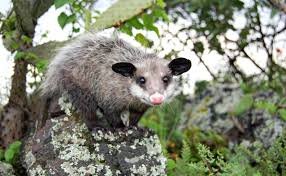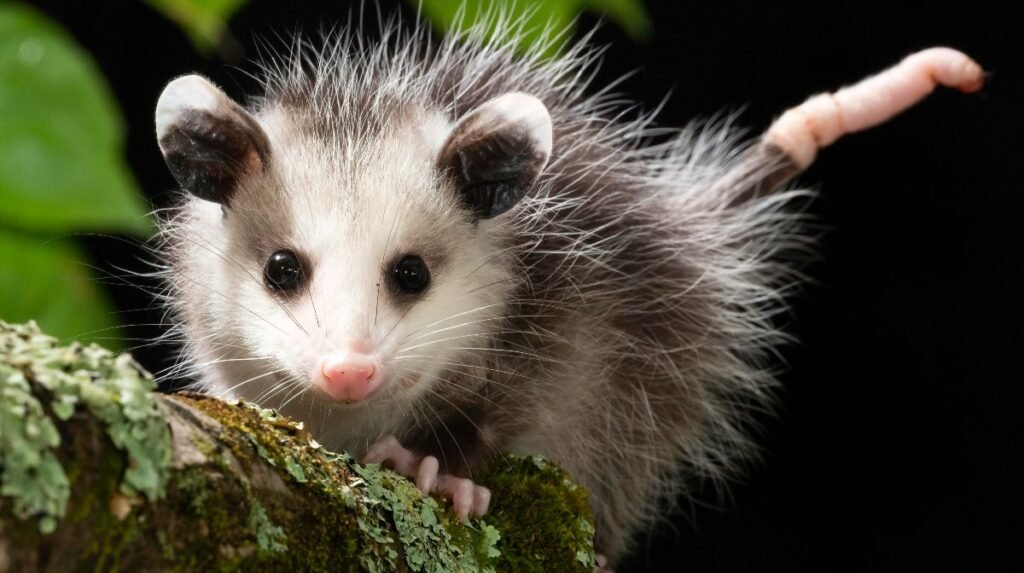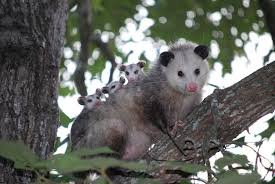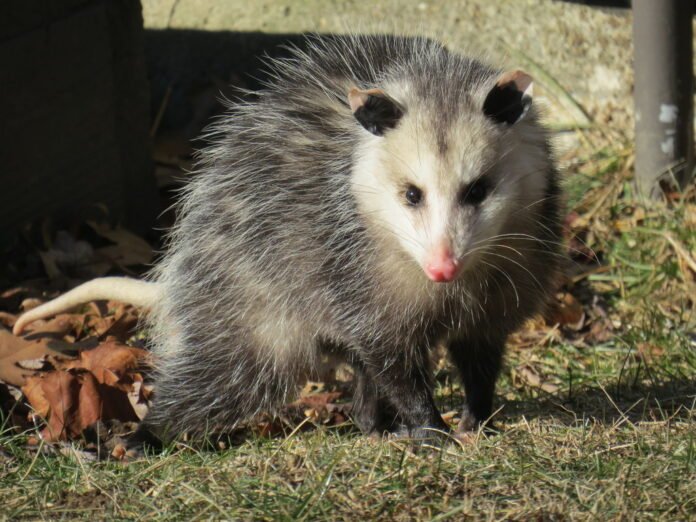Have you ever heard of a tlacuache? This unique creature, often mistaken for a rat, is actually a gentle marsupial found in North America. In this blog post, we’ll uncover the intriguing life of the tlacuache, its habits, and why it’s more fascinating than you might think.
What is a Tlacuache?
In the world of critters, tlacuaches are not your everyday animals. These furry creatures might look like big rats, but they’re actually marsupials. This means they carry their babies in a special pouch, just like kangaroos do. Tlacuaches are mostly found in North America, where they roam around at night looking for tasty bugs and worms to munch on. They might not be the fastest animals around, but they have a special trick – when they’re scared, they play dead! This clever act fools predators into thinking they’re not worth chasing.
The Appearance of Tlacuaches
Tlacuaches are easy to spot once you know what to look for. They’re about the size of a house cat, with a furry tail that can wrap around tree branches. Their fur can range from gray to brown, helping them blend into their surroundings. What sets them apart from rodents like rats is their pointy noses and tiny ears. You might see them scurrying around in your backyard or even climbing up walls with their sharp claws. Despite their appearance, they’re harmless to humans and mostly keep to themselves.

Tlacuaches vs. Rats: What’s the Difference?
Let’s clear up a common misconception: tlacuaches are often mistaken for rats, but they’re quite different. While rats are rodents, tlacuaches belong to the marsupial family, which makes them closer relatives to kangaroos and koalas. Unlike rats, tlacuaches have pouches where their babies develop after birth. They also have a unique immune system that makes them resistant to snake venom, and they love snacking on scorpions and other pests. So, next time you see a tlacuache, remember, it’s a marsupial, not a rodent!
Where Do Tlacuaches Live?
Tlacuaches are adaptable creatures that can make their homes in various environments. Originally found in forests and grasslands, they’ve now adapted to urban life too. You might spot them in parks, gardens, and even in attics or garages. They’re not picky eaters either, feasting on insects, fruits, and even leftover scraps. Despite their ability to live in cities, they still prefer areas with plenty of trees and bushes where they can hide during the day and explore at night.
Tlacuache Diet: What Do They Eat?
When it comes to food, tlacuaches are like the vacuum cleaners of the animal world – they’ll eat almost anything! From juicy insects like beetles and grasshoppers to fruits, nuts, and small mammals, they have a diverse palate. They’re also known for their taste for scorpions and spiders, which might sound scary, but it helps keep these pests in check. This varied diet ensures that tlacuaches always have something to munch on, whether they’re in the wild or scavenging around human settlements.
Unique Features of Tlacuaches
What makes tlacuaches stand out from other animals? For starters, they’re excellent climbers thanks to their strong claws and prehensile tails. This means they can easily scale trees and even vertical walls with ease. Their fur acts as camouflage, blending in with their surroundings to avoid predators. Another fascinating feature is their ability to play dead when threatened, fooling predators into thinking they’re already gone. Tlacuaches are also resilient to venomous bites, making them valuable members of the ecosystem by controlling pest populations naturally.
Tlacuaches as Marsupials: What Does That Mean?
Being a marsupial sets tlacuaches apart from most mammals. Like their cousins in Australia, they give birth to underdeveloped babies that continue to grow and develop in their mother’s pouch. This pouch provides warmth and protection, ensuring the babies stay safe until they’re ready to explore the world on their own. It’s a unique adaptation that allows tlacuaches to thrive in diverse environments, from dense forests to urban landscapes. This marsupial trait also makes them fascinating to scientists studying animal behavior and evolution.
Tlacuache Behavior: Nocturnal Explorers
If you’ve ever wondered what happens when the sun goes down, just ask a tlacuache! These nocturnal creatures come alive at night, using their keen senses of smell and hearing to navigate their surroundings. They spend their evenings hunting for food like insects and fruits, using their sharp teeth to nibble away. During the day, they prefer to rest in hidden spots like tree hollows or cozy nests they’ve built themselves. Their nocturnal habits not only help them avoid predators but also allow them to make the most of their environment when it’s quieter and cooler.
Tlacuaches and Urban Life: How Do They Adapt?
Living in a bustling city isn’t easy for any animal, but tlacuaches have found ways to thrive among humans. They’ve learned to scavenge for food in parks and garbage bins, making use of whatever scraps they can find. Their ability to climb and hide in small spaces helps them avoid detection, making them elusive urban residents. While some people may mistake them for pests, tlacuaches play an important role in controlling insect populations and cleaning up organic waste. Their adaptability ensures that they can coexist with humans while maintaining their natural behaviors.
Predators of Tlacuaches
Despite their clever tricks and adaptations, tlacuaches still face threats from predators. Natural predators like owls, foxes, and larger mammals see them as a tasty snack. Birds of prey, with their keen eyesight and sharp talons, can easily spot a tlacuache scurrying through the grass or climbing a tree. Snakes are another threat, especially in areas where venomous species live. Tlacuaches rely on their speed, agility, and ability to play dead to escape these dangers, but their survival depends on staying alert and avoiding encounters with hungry predators.
Conservation Efforts for Tlacuaches
As urbanization spreads and habitats shrink, conservationists are keeping an eye on tlacuache populations. While they’re adaptable creatures, loss of natural habitat and increased human activity pose challenges. Efforts are underway to protect green spaces and create wildlife corridors where tlacuaches can safely travel between habitats. Educating the public about these misunderstood marsupials is also crucial to dispelling myths and promoting coexistence. By understanding their behavior and habitat needs, we can ensure that tlacuaches continue to thrive in both wild and urban environments.
Fun Facts About Tlacuaches
Did you know that tlacuaches have been around for millions of years? These resilient creatures have adapted to changing environments and survived alongside dinosaurs. They’re also known for their strong sense of smell, which helps them locate food even in the darkest of nights. Despite their small size, they can eat up to their own body weight in food each day! Tlacuaches are also curious animals, known for exploring their surroundings and interacting with other tlacuaches. Their social behavior and communication methods are fascinating topics for researchers studying animal behavior and ecology.
Tlacuaches: Tough Little Guys
Tlacuaches are known for their resilience and toughness. They can survive in diverse environments, from forests to urban areas, adapting to changes in their surroundings. One of their remarkable abilities is their resistance to rattlesnake venom, which makes them valuable predators of snakes and other pests. Despite their small size and slow movement, they use their agility and keen senses to evade predators and find food. Their ability to climb trees and buildings with ease also helps them navigate their environment effectively.

The Importance of Tlacuaches in Ecosystem
As natural predators of insects and small pests, tlacuaches play a crucial role in maintaining ecological balance. By feeding on pests like scorpions, spiders, and beetles, they help control populations that could otherwise become problematic for humans. Their diet also includes fruits and nuts, contributing to seed dispersal and the growth of plant species in their habitats. Tlacuaches are part of a complex web of interactions in their ecosystems, benefiting plants, animals, and humans alike.
Challenges Facing Tlacuaches
Despite their adaptability and resilience, tlacuaches face several challenges in today’s world. Habitat loss due to urbanization and deforestation reduces their natural habitats and food sources. Encounters with humans, who sometimes mistake them for pests, can lead to unintentional harm or relocation. Pollution and climate change also pose threats, affecting their health and food availability. Conservation efforts are essential to protecting tlacuache populations and ensuring their continued survival in the face of these challenges.
Urban Legends and Misconceptions
Despite their beneficial role in ecosystems, tlacuaches are often misunderstood and even feared by some people. Urban legends and misconceptions portray them as pests or carriers of diseases, similar to rats. However, this couldn’t be further from the truth. Tlacuaches do not carry diseases that affect humans, and their diet primarily consists of insects and small animals rather than scavenging through human garbage.
Conservation Efforts
Conservationists and wildlife enthusiasts recognize the importance of preserving tlacuache populations. Efforts are underway to protect their natural habitats, create wildlife corridors, and educate the public about their ecological role. By promoting coexistence and understanding, we can ensure that tlacuaches continue to thrive in their native environments.
Educational Opportunities
Learning about tlacuaches provides valuable insights into animal behavior, ecology, and evolution. Schools and educational programs can incorporate tlacuaches into their curriculum to teach students about biodiversity, adaptation, and the interconnectedness of species in ecosystems. Hands-on experiences, such as visiting wildlife centers or observing tlacuaches in their natural habitats, can inspire future generations to appreciate and protect wildlife.
Future Research Directions
Scientists continue to study tlacuaches to uncover more about their biology, behavior, and adaptations. Research into their immune system, reproductive habits, and interactions with other species can provide valuable information for conservation and management strategies. Understanding how tlacuaches respond to environmental changes can also help predict their resilience and adaptability in the face of future challenges.
Human-Tlacuache Interactions
Interactions between humans and tlacuaches can vary widely depending on cultural beliefs and local attitudes. In some regions, tlacuaches are considered beneficial animals due to their role in pest control, while in others they may be seen as nuisances. Understanding and respecting these animals can foster coexistence and reduce conflicts between humans and wildlife.
Tlacuaches in Folklore and Culture
Tlacuaches have also found their way into folklore and cultural stories across North America. They are often depicted as clever and resourceful creatures, able to outwit larger and stronger animals through their cunning and agility. Stories about tlacuaches highlight their adaptability and survival instincts, making them beloved characters in traditional tales.
The Future of Tlacuaches
Looking ahead, the future of tlacuaches depends on continued conservation efforts and public awareness. Protecting their habitats, reducing human-wildlife conflicts, and promoting sustainable practices are key to ensuring their survival. By valuing tlacuaches as integral parts of ecosystems, we can contribute to biodiversity conservation and ecosystem resilience.
Challenges and Threats
Despite their adaptability, tlacuaches face several challenges in today’s changing world. Habitat loss due to urbanization, deforestation, and agricultural expansion reduces their natural habitats. Fragmentation of habitats can isolate populations and reduce genetic diversity. Pollution, climate change, and human-wildlife conflicts also pose threats to tlacuaches’ survival.
Conservation Efforts
Conservationists and researchers are working to protect tlacuaches and their habitats. Efforts include creating protected areas, restoring degraded habitats, and establishing wildlife corridors. Educating local communities about the importance of tlacuaches and promoting sustainable practices are also critical for their conservation.
Research and Education
Research on tlacuaches continues to expand our understanding of their biology, behavior, and ecological roles. Studies focus on their diet, reproduction, habitat preferences, and interactions with other species. Education initiatives raise awareness about tlacuaches among students, communities, and policymakers, fostering appreciation and support for their conservation.

Community Engagement
Engaging local communities in conservation efforts is essential for the long-term success of tlacuache conservation. Collaborative projects involve local residents in monitoring populations, reducing human-wildlife conflicts, and implementing sustainable land management practices. By involving communities, conservationists can build support for protecting tlacuaches and their habitats.
Future Directions
Looking ahead, it’s crucial to prioritize tlacuache conservation in environmental planning and policy-making. Incorporating their needs into land use decisions, promoting habitat connectivity, and mitigating human impacts are key strategies for their survival. Continued research, monitoring, and adaptive management will inform conservation actions and ensure the persistence of tlacuaches in the wild.
The Role of Tlacuaches in Biodiversity
Tlacuaches play a crucial role in maintaining biodiversity in their ecosystems. As opportunistic omnivores, they help regulate insect populations and contribute to seed dispersal by consuming fruits and nuts. Their presence supports the health of plant communities and promotes ecosystem resilience against environmental changes. By preserving tlacuache populations, we support the overall biodiversity of North American habitats.
Cultural Significance and Folklore
In addition to their ecological importance, tlacuaches hold cultural significance in various indigenous and local traditions. They are featured in folklore as symbols of resilience, adaptability, and resourcefulness. Stories and myths depict tlacuaches as clever creatures that navigate challenges with intelligence and agility, reflecting their real-life survival strategies in diverse environments.
Challenges Facing Tlacuaches
Despite their beneficial roles and cultural significance, tlacuaches face numerous threats to their survival. Habitat loss due to urban development, agricultural expansion, and deforestation fragments their habitats and reduces available resources. Climate change exacerbates these challenges, altering ecosystems and impacting tlacuache populations. Conservation efforts are essential to mitigate these threats and secure a future for tlacuaches in the wild.
Conservation Strategies
Conservationists employ various strategies to protect tlacuaches and their habitats. These include establishing protected areas, restoring degraded habitats, and promoting sustainable land management practices. Collaborative efforts with local communities involve education, awareness-raising, and fostering coexistence between humans and tlacuaches. By addressing threats and implementing conservation measures, we can safeguard tlacuaches for future generations.
Conclusion
In conclusion, tlacuaches are fascinating creatures that deserve our admiration and respect. Despite their rat-like appearance, they are marsupials with unique adaptations and behaviors. From their pouches for carrying babies to their ability to play dead when threatened, tlacuaches have evolved to thrive in diverse environments. As urbanization continues to change landscapes, it’s important to appreciate the role tlacuaches play in ecosystems and take steps to conserve their habitats. By understanding and protecting these resilient marsupials, we can ensure that future generations will continue to marvel at their unique traits and contributions to nature.

